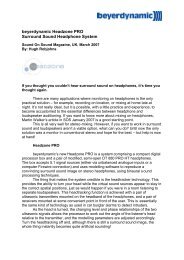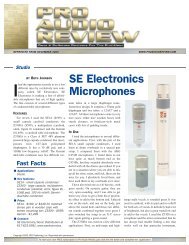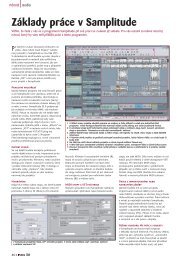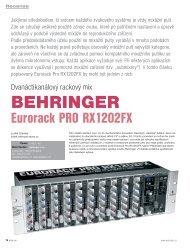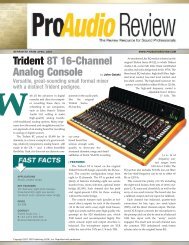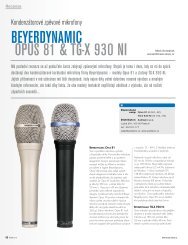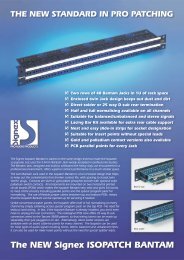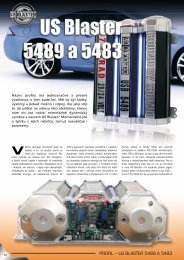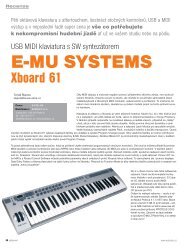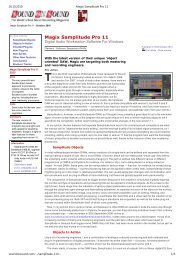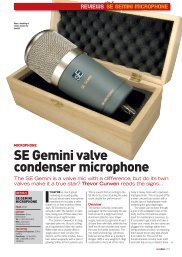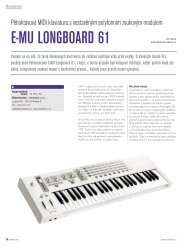SE Electronics Titan http://www.soundonsound.com/sos/nov05 ...
SE Electronics Titan http://www.soundonsound.com/sos/nov05 ...
SE Electronics Titan http://www.soundonsound.com/sos/nov05 ...
Create successful ePaper yourself
Turn your PDF publications into a flip-book with our unique Google optimized e-Paper software.
<strong>SE</strong> <strong>Electronics</strong> <strong>Titan</strong><br />
<strong>http</strong>://<strong>www</strong>.<strong>soundonsound</strong>.<strong>com</strong>/<strong>sos</strong>/<strong>nov05</strong>/articles/setitan.htm?print=yes<br />
1 z 3 23.8.2006 13:05
<strong>SE</strong> <strong>Electronics</strong> <strong>Titan</strong><br />
<strong>http</strong>://<strong>www</strong>.<strong>soundonsound</strong>.<strong>com</strong>/<strong>sos</strong>/<strong>nov05</strong>/articles/setitan.htm?print=yes<br />
2 z 3 23.8.2006 13:05<br />
In this article:<br />
<strong>Titan</strong> Trials<br />
Verdict<br />
<strong>SE</strong> <strong>Electronics</strong> <strong>Titan</strong><br />
£999<br />
pros<br />
Flattering, musical sound.<br />
Good transient response<br />
without harshness.<br />
Distinctive appearance<br />
should impress the clients!<br />
High-quality packaging and<br />
shockmount.<br />
cons<br />
Because the mic seems to<br />
pick up more room ambience<br />
in cardioid mode than the<br />
other models I <strong>com</strong>pared it<br />
with, more care may need to<br />
be taken over the local<br />
acoustic environment when<br />
recording.<br />
summary<br />
I still don't know how much<br />
of this mic's sound is down<br />
to the use of titanium, but it<br />
certainly has a subtly<br />
flattering musicality of its<br />
own.<br />
information<br />
£999 including VAT.<br />
Sonic Distribution +44<br />
(0)1582 470260.<br />
+44 (0)1582 470269.<br />
Click here to email<br />
<strong>www</strong>.sonicdistribution.<strong>com</strong><br />
<strong>www</strong>.seelectronics.<strong>com</strong><br />
<strong>SE</strong> <strong>Electronics</strong> <strong>Titan</strong><br />
Multi-pattern Condenser Microphone<br />
Reviews : Software<br />
Published in SOS November 2005<br />
Print article : Close window<br />
The capsule within this microphone has a diaphragm coated with<br />
titanium, rather than the usual gold. We find out whether it<br />
makes a difference.<br />
Paul White<br />
Most large-diaphragm condenser microphones doing the rounds today<br />
are based around a gold-coated mylar diaphragm, where the gold is<br />
either evaporated or sputtered onto mylar film prior to capsule assembly.<br />
This is also true of most of the <strong>SE</strong> <strong>Electronics</strong> microphone range, though<br />
their new and distinctively styled multi-pattern <strong>Titan</strong> is something of a<br />
departure from this tradition, because it uses titanium rather than gold for<br />
the conductive diaphragm coating.<br />
Apparently, titanium is much more dimensionally stable than gold when<br />
subjected to temperature change. Vocal mics in particular have to exist in<br />
a fairly harsh environment, where warm, damp air is being breathed over<br />
them all the time, so if the gold expands at a different rate to the mylar<br />
beneath it, then it's reasonable to assume that the mic's character will<br />
change.<br />
Another issue is that gold-coated diaphragms can wrinkle over time due Photos: Mike Cameron<br />
to the unevenly matched expansion coefficients of gold and mylar,<br />
whereas the <strong>SE</strong> <strong>Electronics</strong> designers expect titanium to give better longevity in this respect.<br />
Beyond such matters of stability, I can't see why the choice of metal should affect the tonality of the<br />
microphone in any significant way, as its primary function is to act as a charge-carrying electrode,<br />
though the designers believe that it is a significant contributory factor. The bulk of the moving mass<br />
is made up of the mylar —the metallic coating is typically only a few atoms thick, whereas mylar<br />
membranes tend to be between three and six microns thick — so I would have thought that the<br />
mechanics would have been dominated by the physical properties of the mylar rather than its<br />
conductive coating.<br />
The casework and shockmount design are certainly eye catching, but other than the new diaphragm<br />
material the rest of the engineering design is unashamedly traditional. Centre termination has been<br />
used for the dual-diaphragm, multi-pattern capsule, while the onboard preamp is based around<br />
tried-and-tested Class-A FET circuitry with a transformerless balanced output stage.<br />
The mic needs only standard 48V phantom power, and there are horizontal toggle switches below<br />
the basket to bring in a 10dB pad and a low-frequency roll-off filter. A further switch selects cardioid,<br />
omni, or figure-of-eight polar patterns. According to the manual, the microphone has a particularly<br />
good transient response, so in addition to its obvious application as a vocal microphone it should<br />
also be well suited to recording percussive instruments.<br />
On paper, the <strong>Titan</strong>'s frequency response covers 20Hz-20kHz, but checking the frequency plot<br />
reveals a gently rising response with a presence peak up at around 10kHz, which no doubt helps the<br />
microphone resolve transient detail. The sensitivity of the microphone is 40mV/Pa ±2dB (reference<br />
1V/Pa at 1kHz), which puts it in about the same ball park as other studio capacitor microphones, but<br />
the 18dBA EIN, while typical of many <strong>com</strong>peting products, is not nearly as quiet as the best. The<br />
maximum SPL for 0.5 percent THD at 1kHz is 128dB, which again isn't particularly high by modern<br />
standards, but should be adequate for anything other than close-miking exceptionally loud sources<br />
such as kick drums and some brass instruments.<br />
The mic's circuitry is mounted on two small circuit boards, with surfacemount <strong>com</strong>ponents appearing<br />
alongside discrete FETs and transistors to increase the board density. The capsule, which is around<br />
one inch in diameter, is perched on an isolation mounting inside the dual-layer, spherical steel<br />
basket, while the body itself is made from machined brass. I feel the basket could have been made a<br />
bit tougher, but provided that you take reasonable care with the mic, it should stand up fine to<br />
normal usage and it could be argued that anything heavier might have interfered with the sound.<br />
A further machined locking ring secures the microphone to the included shockmount, and the whole<br />
kit is shipped in a foam-lined camera case, <strong>com</strong>plete with an XLR cable.<br />
<strong>Titan</strong> Trials<br />
I set up the <strong>Titan</strong> in its shockmount and tried it first on vocals. Its resistance to popping seemed<br />
rather better than that of most capacitor mics, no doubt due to the larger than usual basket.<br />
Because there are very few physical obstructions close to the capsule, the sound is also rather less
<strong>SE</strong> <strong>Electronics</strong> <strong>Titan</strong><br />
<strong>http</strong>://<strong>www</strong>.<strong>soundonsound</strong>.<strong>com</strong>/<strong>sos</strong>/<strong>nov05</strong>/articles/setitan.htm?print=yes<br />
3 z 3 23.8.2006 13:05<br />
constricted and more three-dimensional than I'm used to hearing from a large-diaphragm<br />
microphone, especially when in cardioid mode, which is the most challenging in this respect. Having<br />
said that, a separate pop shield is still a good idea, as you can make the mic pop if you try.<br />
When working fairly close to the microphone, the proximity<br />
effect adds a degree of warmth without making the sound<br />
boomy or over-coloured, though the low-cut switch can be<br />
brought in if necessary to counter this. While the low end is<br />
warm and solid, the high end is open and airy, but in a very<br />
smooth way. Overall, the sound is flattering and intimate, but<br />
not at all hard or harsh.<br />
My tests with acoustic guitar were interesting, because right<br />
away I felt the mic was picking up rather more of the room<br />
ambience in cardioid mode than the other cardioid mics I was<br />
using for <strong>com</strong>parison. In the right room, this conjures up a<br />
nice sense of space, but where the room is less than ideal it<br />
may be necessary to take a little more care than usual setting<br />
up acoustic absorbers around the recording area. I can only<br />
assume from this that the cardioid pattern is on the wide side<br />
of normal, and though this means that the angle of capture is wider, it also tends to produce a more<br />
open sound with better rear rejection than a tightly focussed cardioid. The tonal change between<br />
cardioid and figure-of-eight is subtle, and moving to omni opens the sound up more, involving the<br />
room ambience to a greater extent.<br />
Finally I tested the mic on some hand percussion and found that it captured the transient character<br />
of the sound in a very convincing and natural way. As with acoustic guitar, you get the impression of<br />
accuracy, though in reality there is some subtle flattery going on. What the <strong>Titan</strong> doesn't do is add an<br />
artificial edge to transient sounds as some mics seem to do — the result is always very musical and<br />
spacious.<br />
Verdict<br />
The <strong>Titan</strong> <strong>com</strong>es towards the top of the <strong>SE</strong> <strong>Electronics</strong> price range and is aimed at professional<br />
users and very serious project studios. I can't say for sure that the mic would sound any different if a<br />
conventional gold coating had been used in place of titanium, but, whatever the technical reasons,<br />
this microphone has a distinct and very musical character.<br />
As a vocal mic, the <strong>Titan</strong> should suit a wide range of singers and styles, as its presence peak is<br />
above that part of the spectrum responsible for harshness, while its subtle flattery really makes for a<br />
classy and intimate sound. What struck me most on a subjective level was the spacious and<br />
involving sound in cardioid mode, though the silky top end is equally impressive in its ability to open<br />
up the sound and enhance detail without adding hardness or sounding in any way brash.<br />
Overall, the <strong>Titan</strong> certainly doesn't sound like a 'me too' microphone, and I'm sure it will take its place<br />
alongside the Gemini as a serious contender that people choose because of its distinctive sonic<br />
character.<br />
Published in SOS November 2005<br />
Sound On Sound, Media House, Trafalgar Way, Bar Hill, Cambridge CB3 8SQ, UK.<br />
Email: <strong>sos</strong>@<strong>soundonsound</strong>.<strong>com</strong> | Telephone: +44 (0)1954 789888 | Fax: +44 (0)1954 789895<br />
All contents copyright © SOS Publications Group and/or its licensors, 1985-2006. All rights reserved.<br />
The contents of this article are subject to worldwide copyright protection and reproduction in whole or part, whether mechanical or electronic, is expressly<br />
forbidden without the prior written consent of the Publishers. Great care has been taken to ensure accuracy in the preparation of this article but neither Sound<br />
On Sound Limited nor the publishers can be held responsible for its contents. The views expressed are those of the contributors and not necessarily those of<br />
the publishers.<br />
Web site designed & maintained by PB Associates | SOS | Relative Media




